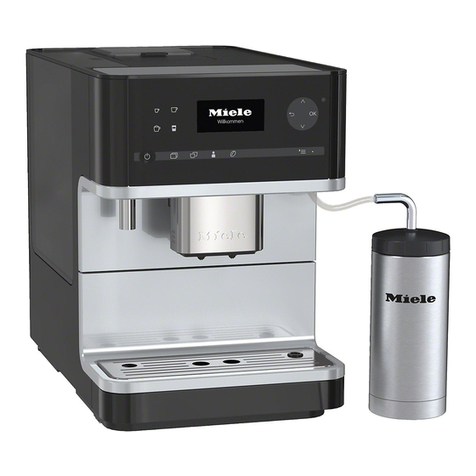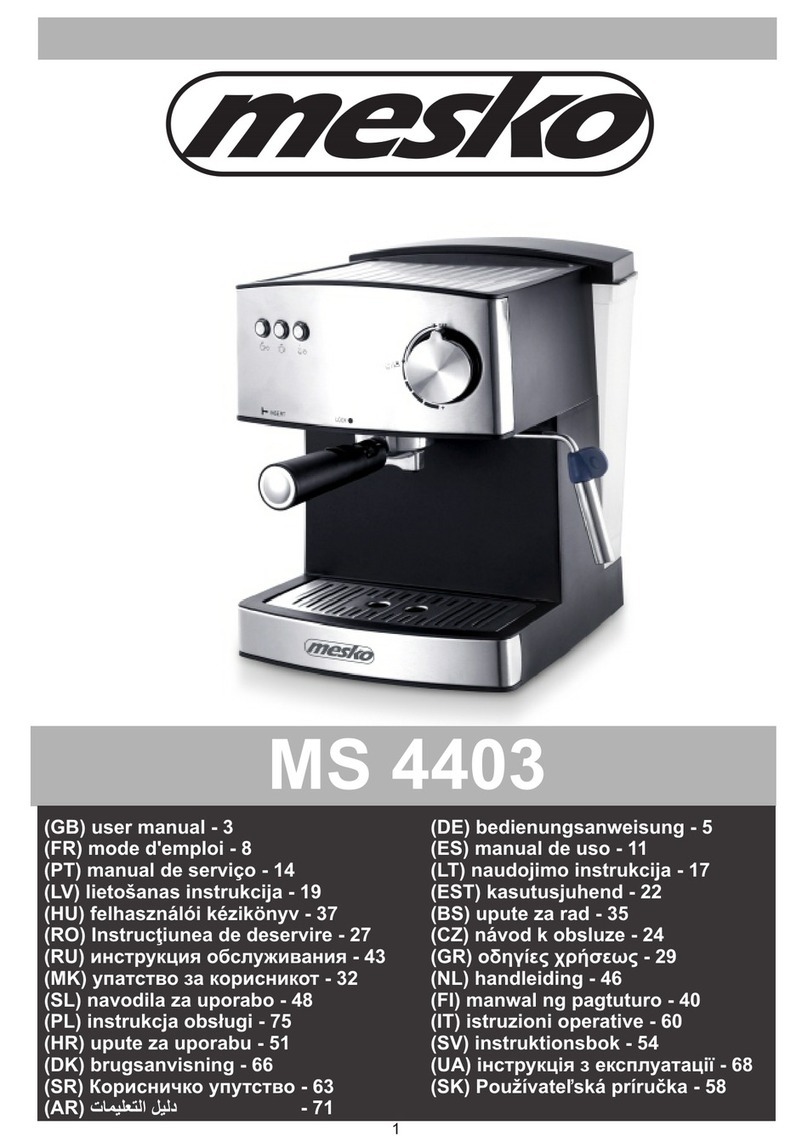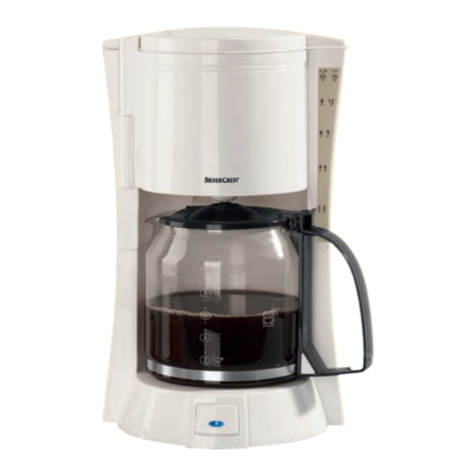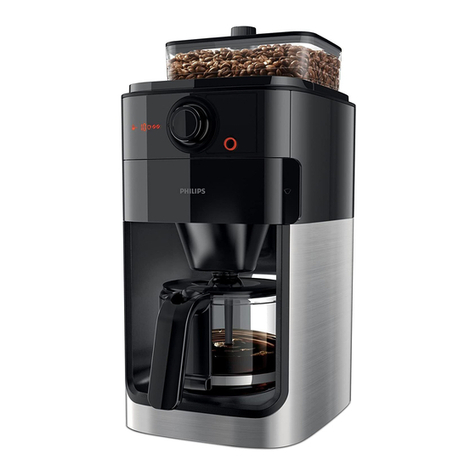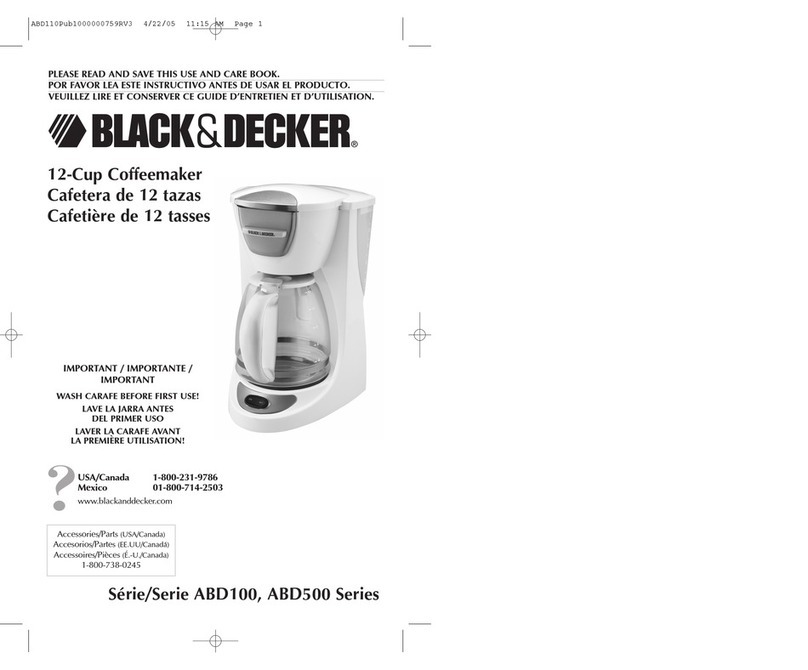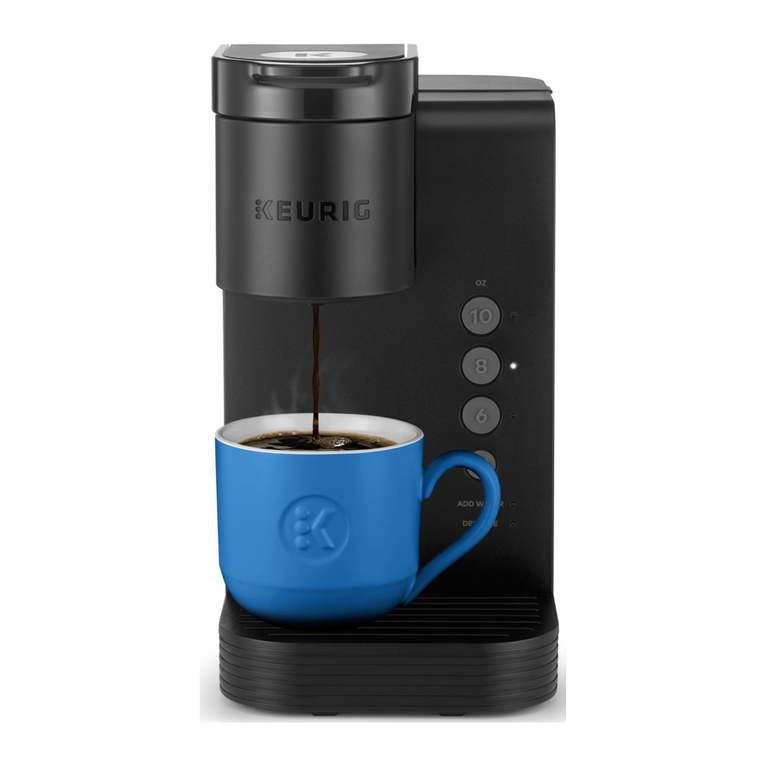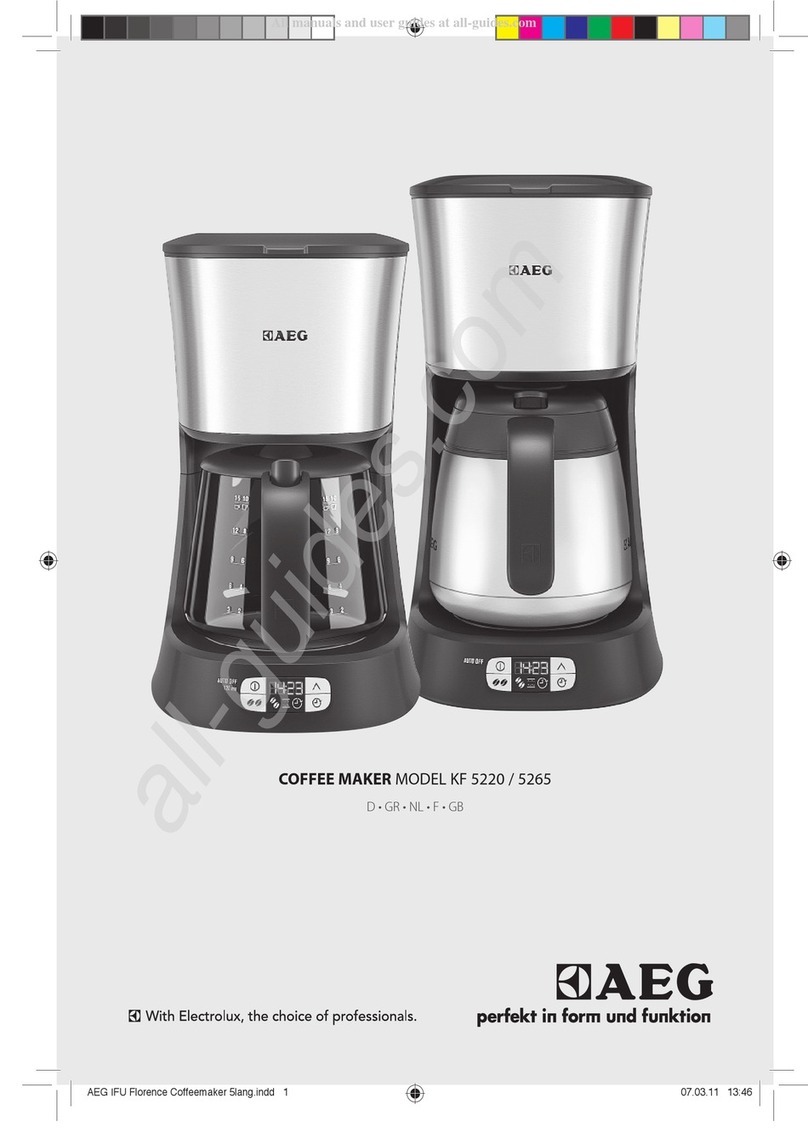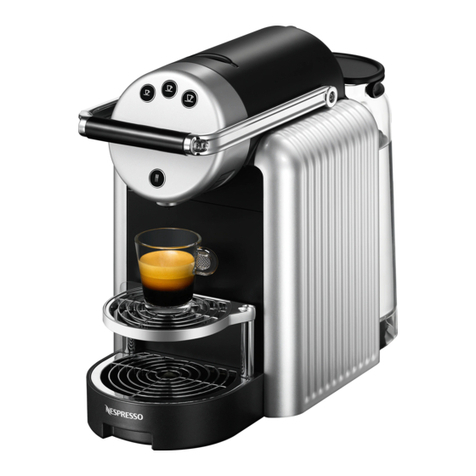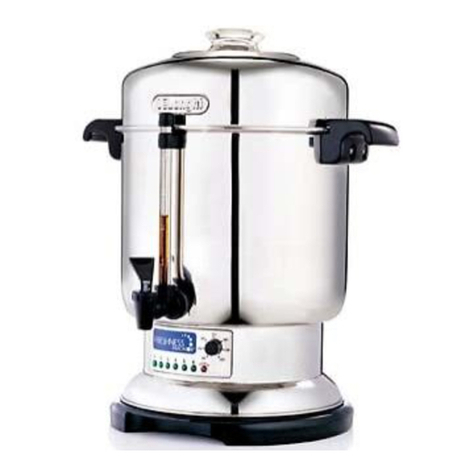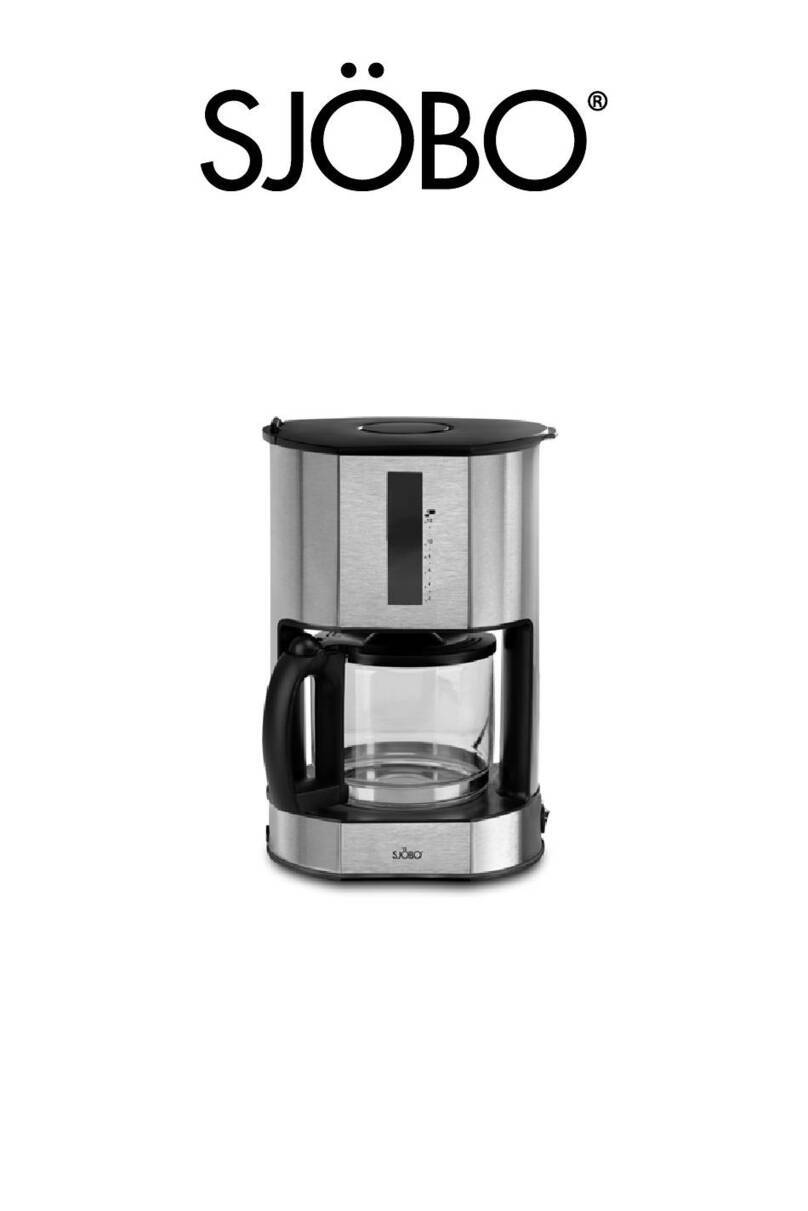Lazpaziale S1 Dream-T User manual

Espresso Machine
Made In Italy
By
Owner’s Manual

S1 Dream-T Espresso Machine
Owner’s Manual Page 1
Diagrams
1. Steam Wand
2. Hot Water Faucet
3. Steam Knob
4. Cup Warming Tray
5. Touchpad/Display
6. Card Reader Interface
7. Group Head
8. Drip tray
9. Power Button
10. Display
11. Menu/Ok Button
12. Hot Water Button
13. Steam Boiler Button
14. Single Shot Button
15. Manual Shot Button
16. Double Shot Button
17. Menu Navigation Button
18. Group Gasket (Spare)
19. Coffee Tamper
20. Cleaning Brush
21. Coffee Scoop
22. Shower Screens (Spare)
23. Backflush Disc
24. Single Portafilter
25. Double Portafilter
26. Shower Screen Removal Tool
27. Card Reader/Memory Card

S1 Dream-T Espresso Machine
Owner’s Manual Page 2
Introduction
First of all, thank you for your business! You are going to love your new S1 Dream-T
espresso machine. It combines classic beauty, value, and great performance for making
the best espressos, cappuccinos, and lattes you‟ve ever tasted! These instructions include
tips that will help bring out the Barista that‟s hidden within! Enjoy your new machine!
First Time Set Up
Remove the machine from the box and screw the legs into the threaded inserts on the
base of the machine.
Remove the water reservoir and rinse it thoroughly. It may be cleaned with mild dish
detergent, but it is not recommended for dishwasher use.
Before filling the reservoir, test your water for hardness with the provided test strips.
Fill a glass with cold tap water; dip the tip of the test strip into the water for one second,
then pull the strip out of the water and hold it horizontally for fifteen seconds. After
fifteen seconds, compare the color of the strip to the chart on the side of the package to
determine how many grains of hardness are in your tap water. The chart below will tell
you how many gallons of water can be softened before the in-tank softener needs to be
replaced.
Fill the reservoir with cold water making sure the
in-tank softener is suction cupped to the bottom in
an upright position as shown to the right.
Return the reservoir to the machine being careful not
to spill any water inside. Then push the drip tray into
place and then it will lock down into notches on each
side of the frame so the reservoir does not back out.
Warning: Do not turn the machine on until following the procedure on the next page or
damage to the machine will occur and will not be covered under warranty.

S1 Dream-T Espresso Machine
Owner’s Manual Page 3
First Time Set Up - Filling the coffee boiler
Plug the machine into the electrical outlet, but do NOT turn it on. A GFI outlet is
recommended to better protect the machine, but is not necessary.
With the machine turned off press and hold the
button for approximately 5 seconds. The display will
then show the message shown to the right.
Press either the single or double shot button to start
filling the coffee boiler.
When done filling the coffee boiler then press the to return to standby mode.
After filling the coffee boiler then refill the water reservoir before turning the machine on
so there will enough water to fill the steam boiler.
Turning the machine on for the first time
Press and hold the button for approximately 3 seconds until the display lights up. The
pump will come on to start filling the steam boiler and will turn off once it is filled.
After the pump has turned off from filling the steam boiler then press the button for
approximately 15 seconds until you have water flowing from the grouphead and then
press the button again to stop the flow.
Whichever portafilter you intend to use then lock it into the grouphead so it will warm up
with the machine.
If you plan on using the steam boiler for steaming milk then press the button.
Allow the machine to heat up for at least 30 minutes for optimal performance and
temperature stability. It is very important to keep the portafilter in the grouphead and
also keep the cups on the cup warming tray. Failure to do so will result in a cold and
sour shot.
Set the grind particle size on your grinder. This is very important to achieve good
results. Set the grind so that a 2oz double shot comes out in about 25 seconds.
The grind should be finer than salt, but coarser than powder.

S1 Dream-T Espresso Machine
Owner’s Manual Page 4
Basic machine operation
Turning The Machine On And Off To turn the machine on press and hold the button for
approximately 3 seconds until the machine turns on.
To turn the machine off quickly press the button. (Do not hold button down)
Pulling Shots There are a few ways you can pull a shot with the S1 Dream-T. You can use one
of the two programmable shot buttons, single or double . These buttons can be
individually programmed for volume and temperature. The shots will automatically stop
dispensing at the desired level or you can press the same button again to stop the shot at any
time.
You can also pull a shot using the manual button The manual button will use the existing
temperature setting, but will not turn off on its own. To pull a shot with the manual button press
the button to start the shot and then press the button again to stop the shot when it has
reached the desired level. This button is also useful for cleaning the group, backflushing, and
rinsing or pre-heating the portafilter.
Turning The Steam Boiler On And Off The steam boiler can be turned on/off independently
from the coffee boiler. This is helpful if you will not be steaming milk and want to save on
energy consumption. To turn the steam boiler on press the button. Press the button
again to turn the steam boiler off.
Using The Hot Water Faucet To use the hot water faucet the steam boiler must be on and up
to pressure. Under the menu in profiles the hot water faucet can be set up to work as a manual
button or can be programmed to discharge a set amount of water each time. For manual mode
if you press the button, the water will start to flow and then press the button again to
stop the flow of water. It is not recommended to remove more than 6oz of water at any given
time until the boiler has had time to refill.
In automatic mode the button can be programmed to give a pre-set amount of water and
will automatically stop dispensing without having to press the again to stop dispensing.
Accessing The Menu To access the menu press and hold the button for approximately 3
seconds until the menu appears on the display. Then use the up/down arrow keys to cycle
through the menu and then press the button to select a menu item to view or change.
To exit the menu press the up arrow key until “Home” is displayed at the top of the screen and
then press the button to return to normal operation.

S1 Dream-T Espresso Machine
Owner’s Manual Page 5
Understanding The Display
The display is the information center for the S1 Dream-T. It will tell you the time, boiler,
temperatures, water pressure, and will also give you an alarm message in the event of a
component failure. The diagram below shows the display in normal operation mode.
1. Current Active User Profile
2. Coffee Boiler Temperature
3. Time Of Day
4. Indicates If Water Supply Is Present
5. Water Pressure (Shows line pressure when idle and pump
pressure when pump is engaged)
6. Steam Boiler Temperature (Steam boiler must be on)
7. Indicates Steam Boiler Is Turned On
Power Modes
The S1 Dream-T can be set up to work in full power mode. In full power mode the machine
draws 20amps of power so a 20 amp receptacle and breaker must be used. If one is not
available then full power mode should be turned off.
In full power mode the machine is able to heat both boilers at the same time. This is helpful if
you want to be able to pull a shot and steam milk at the same time.
When full power mode is turned off then it is only able to heat one boiler at a time and will
always give priority to the coffee boiler. In this mode it is recommended to pull a shot and
steam milk separately or the machine may lose steam pressure if done at the same time.
Warning: Using the machine in full power mode in a 15 amp outlet should never be done.
Failure to follow this warning could pose a fire hazard and is not recommended.

S1 Dream-T Espresso Machine
Owner’s Manual Page 6
Brewing Espresso
First let me begin by explaining the three main variables of preparing great espresso.
1. Quantity of ground coffee
2. Tamping
3. The grind
Quantity of ground coffee - Loosely fill the basket slightly mounding over the top. Then
lightly run your finger arched across the basket from left to right, right to left, front to back,
and then lay your finger flat on the basket and go from back to front to remove any excess
coffee. This technique helps fill any voids in the basket to help achieve an even extraction.
Tamping - After filling the basket with coffee then use your tamper to apply 30lbs of
pressure evenly on the coffee bed. Then without applying any pressure lightly twist the
tamper on the bed of coffee to “polish” the loose grounds on top. Then lock the portafilter
firmly into the group head and then press either shot button. It is very important to tamp
consistently with the same pressure each time or your shot quality and timing will vary.
The grind - Adjust your grind so that when you activate the pump, the flow of coffee
coming out of the portafilter spout looks like the tapered tail of a mouse. It should take
approximately 25 seconds for a 2 oz. double shot. If it is coming out quicker then the grind
needs to be adjusted finer, if it is coming out slower or not at all then the grind should be
adjusted coarser. The grind particle size should look in between powder and salt. Not as
fine as powder, but not as coarse as salt. Getting the right grind is crucial to making
delicious espresso with thick rich crema.
Consistency -The quantity of ground coffee and tamping pressure should always be the
same. Using more or less coffee or tamping lighter or harder will greatly affect the outcome
and timing of the shot. If the shots are not coming out properly then the only variable that
should be changed is the grind.
Cooling Flush -A cooling flush is not needed on a dual boiler machine and may actually
ruin the temperature stability of the shot and is not recommended for optimal performance.
Cleaning Tip: Get into the habit of disposing of the spent grounds immediately after brewing
espresso. After disposing of the grounds, return the portafilter to the group head and raise
the brew lever for a few seconds to rinse away excess oils and loose grounds. By regularly
following this procedure, you will greatly reduce the tar-like buildup on the shower screen
that occurs if you allow coffee oils to dry and bake on the hot group.

S1 Dream-T Espresso Machine
Owner’s Manual Page 7
Steaming Milk - Basics
First, let‟s talk about some of the things you need to learn in order to become „barista-like‟ in
your techniques.
Milk –Whole milk works best to steam, both in technique and in flavor! Lower fat milks contain
mostly water which will not foam well and will be almost tasteless when steamed. After all your
hard work you will be left with a less than desirable tasting beverage.
Temperature –Your whole milk needs to be as cold as possible to ensure the creamiest,
sweetest, and best tasting micro-foam. Once the milk has reached a temperature between
150-160 degrees, you must stop the process. The longer amount of time you have with the
cold milk gives you that extra time to continue making the milk creamy and sweet tasting. Milk
heated above 160 degrees will be burnt and taste terrible.
Frothing Pitcher –The size of your pitcher is relative to the size and number of drinks you will
be preparing at the time. Our recommendation on pitcher choices would be our own “Pro
Barista Steaming Pitcher” which has become the pitcher of choice of the renowned baristas
who helped train Chris‟ Coffee Service in this frothing technique. These baristas felt the Pro
Barista Steaming Pitcher promoted a user friendly rolling of the milk which made it simple to
create thick rich micro-foam for pouring Latte Art.
Amount of Milk –Too little milk in your frothing pitcher will cause splashing when you turn on
the steam arm; too much milk will cause overflow and make a huge mess. The pitcher must
be filled between 1/3 to 1/2 full to have the maximum capacity for properly steaming milk. If
your pitcher has a spout, fill it to half an inch below where the spout starts.
Stretching the milk –Refers to the initial heating of the milk and the forceful introduction of air.
Stretching continues until the milk reaches an approximate temperature of 100 degrees or
“body temperature”
Texturizing the milk –Refers to the next phase of frothing whereby the steam wand is
submerged in the milk and the pressure continues to roll the milk. This process breaks down
the large air bubbles into tiny air bubbles which then creates the smooth and creamy texture
that is most desirable.
Note –It is highly recommended to steam your milk before pulling your shot. It is also
recommended to not use a steaming pitcher that is larger than 20oz for optimal performance.

S1 Dream-T Espresso Machine
Owner’s Manual Page 8
Steaming Milk - Technique
As you face your espresso machine, point the steam arm over your drip tray and open up
the steam valve in order to purge out any unwanted water that may have collected inside
the wand due to condensation –you do not want that added to your delicious beverage!
Next, position the steam arm so it is facing directly toward you and slightly angle it 45
degrees from the base.
Holding your half-filled steam pitcher with the handle facing you, submerge the tip of the
steam wand approximately an inch below the surface of the cold milk. Your pitcher bottom
should be parallel with the countertop. The steam arm should gently rest in the spout of the
steam pitcher. Now slightly tilt the pitcher left, keeping the arm away from the side of the
pitcher. Open the steam knob completely and position the pitcher so the tip is just below
the surface of the milk. This action creates the „stretching‟ of the milk –in other words,
adding air to the milk. When done properly, the sound you hear at this point resembles
„sucking‟. You continue this until the milk reaches an approximate temperature of 100
degrees or “body temperature”.
After your milk has reached this „body temperature‟, submerge the tip of the steam arm
approximately one inch below the surface of the milk to get the milk spinning. This process
continues to roll the milk over itself again and again –breaking the large air bubbles into
tiny air bubbles –resulting in a new creamy and sweeter „texture‟of the milk. When your
milk has reached approximately 155 degrees or the bottom of the pitcher becomes too hot
to hold then turn the steam knob off.
Using a steaming thermometer is helpful when you are learning to steam milk. As you gain
more experience and become more comfortable with the process you will be able to steam
milk without the help of a thermometer. If you notice in the procedure above we mention
temperatures and we also mention “body temperature” and the pitcher being “too hot to
hold” We mention this because body temperature is 98.6 which is real close to 100 degrees
and when the pitcher becomes too hot to hold the milk will be around 150 degrees. This
makes it very easy to steam milk without a thermometer. You will “stretch” the milk until the
pitcher becomes body temperature and then you start the “texturizing” of the milk until the
pitcher becomes too hot to hold on the bottom and then you‟re all done.

S1 Dream-T Espresso Machine
Owner’s Manual Page 9
Steaming Milk - Tips
Helpful Tips and Information
When turning the steam knob off, always keep the tip under the surface of the milk for
approximately 3 seconds. If you pull it out too soon, you will destroy the nice velvety
micro-foam.
After removing the steam wand from the milk, position it over the drip tray and then
open the steam knob for 1-2 seconds to clean out any trapped milk inside the tip and
then wipe it down with a damp cloth immediately or the milk will dry out on the steam
wand and will be difficult to clean.
While texturizing the milk, if you lower the tip too far into the milk you create turbulence
rather than rolling. Turbulence will not make micro-foam.
If there are a few bubbles in the milk after you have finished, wait 5-10 seconds to allow
all the remaining bubbles to surface, then simply tap the edge of the pitcher on the
counter and swirl the milk slightly and they will disappear.
Be sure to keep your steamed milk moving/swirling until you are ready to pour since
milk has a natural tendency to separate.

S1 Dream-T Espresso Machine
Owner’s Manual Page 10
Maintenance
Backflushing is a vital maintenance procedure you must follow to help keep your machine
running flawlessly for years to come. There are two types of backflushing; one with plain
water, and the other with espresso machine cleaner.
Plain water backflushing should be done at least once a week, however if you are so
inclined, feel free to backflush with plain water as often as you like. It won't harm the
machine and keeps the shower screen clean.
To backflush, you insert the rubber backflush disc into one of your portafilters. It is
recommended to use your double portafilter as it will make a better seal.
To perform a plain water backflush, place the portafilter into the group head. Then activate
the manual button and let it run for around 20 seconds and then press the manual button
again to stop the flow. There will be a discharge of water into the right side of the drip tray
which is normal. Repeat three to five times.
Backflushing with espresso machine cleaner is the same procedure as above with a few
minor differences. The first difference is backflushing with espresso machine cleaner only
needs to be done approximately once every 2 weeks or every 35-50 espressos. I don't
recommend backflushing with cleaner more often than once every two weeks.
To begin, place 1/4 of a teaspoon of espresso machine cleaner into the backflush disc in
the portafilter and then lock the portafilter into the grouphead. Now follow the same
procedure as above until the cleaner is dissolved and the water runs clear (about 5-10
flushes). Remove the portafilter from the group and rinse thoroughly. Then take a damp
cloth and wipe the underside of the group. After you have finished this procedure, I
recommend you pull a shot of espresso and dispose of it to cure the group. You're finished
and ready for another month of espresso.

S1 Dream-T Espresso Machine
Owner’s Manual Page 11
Warranty
The S1 Dream comes with a 1 year warranty starting from the original date of purchase to
protect against defects in materials or workmanship. The warranty is void if the product has
been damaged by abuse, neglect, or modification. For more detailed information about the
warranty please visit our website at the following link: http://www.chriscoffee.com/policy
We Are Here To Help
Enjoy your new espresso machine and remember, should you have any questions, either
visit our FAQ section at the bottom of our web site or contact my staff or me by phone at
518-452-5995 or by email at [email protected]
Please remember: Save the shipping carton and all the packing material that came with
your machine. This is very important should you need to return your machine to us. If you
do need to send your machine back for any reason, you must first call our service
department and obtain a Return Authorization number prior to shipping. Be sure to insure
your machine and pack it securely. We can‟t be responsible for any damage that might
occur while in transit to us. Properly packing your machine with the original carton and
packing material minimizes this possibility. Should it be necessary for you to file a damage
claim with the shipper, we will of course be happy to assist you with the required forms.
Thank you again for your business,
Table of contents
Popular Coffee Maker manuals by other brands
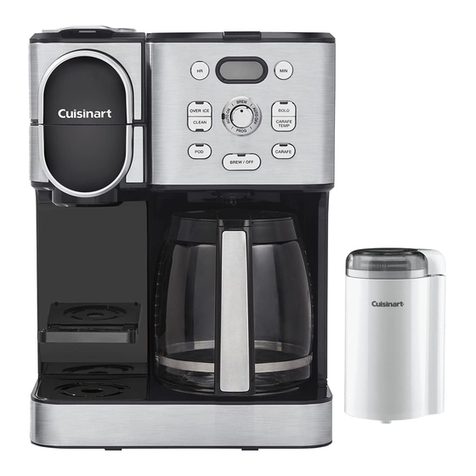
Cuisinart
Cuisinart Coffee Center SS-16 Series Instruction booklet
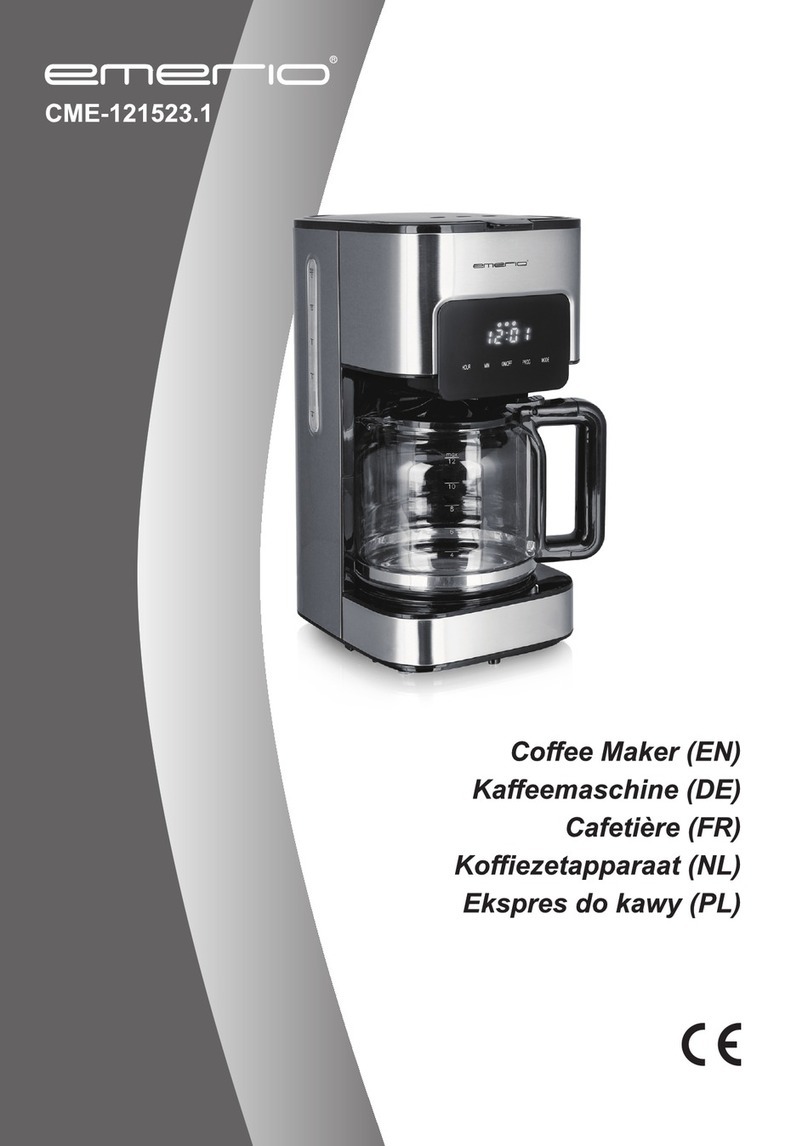
emerio
emerio CME-121523.1 instruction manual
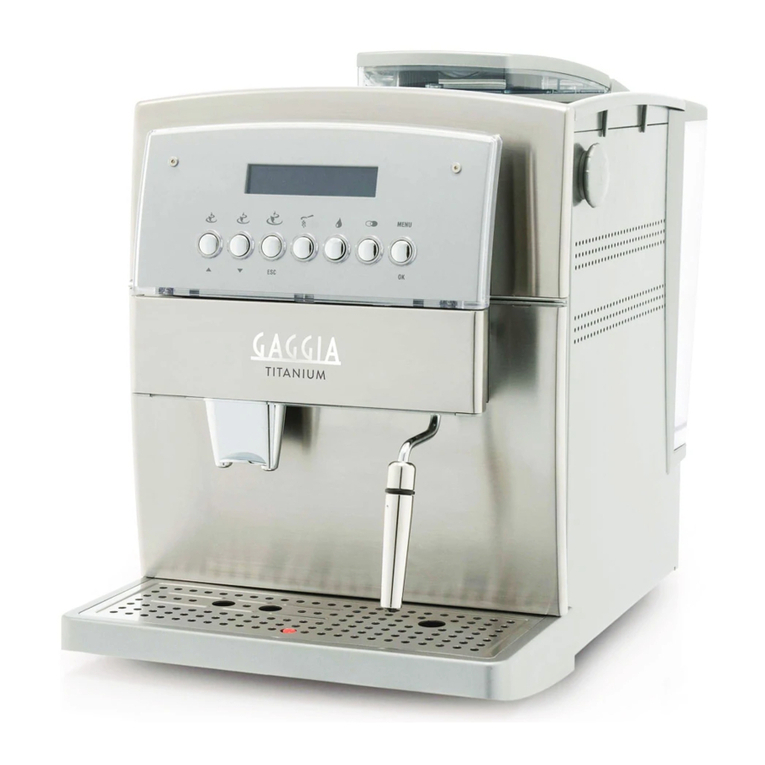
Gaggia
Gaggia TITANIUM operating instructions

Brandt
Brandt CTI-915 Instructions for use
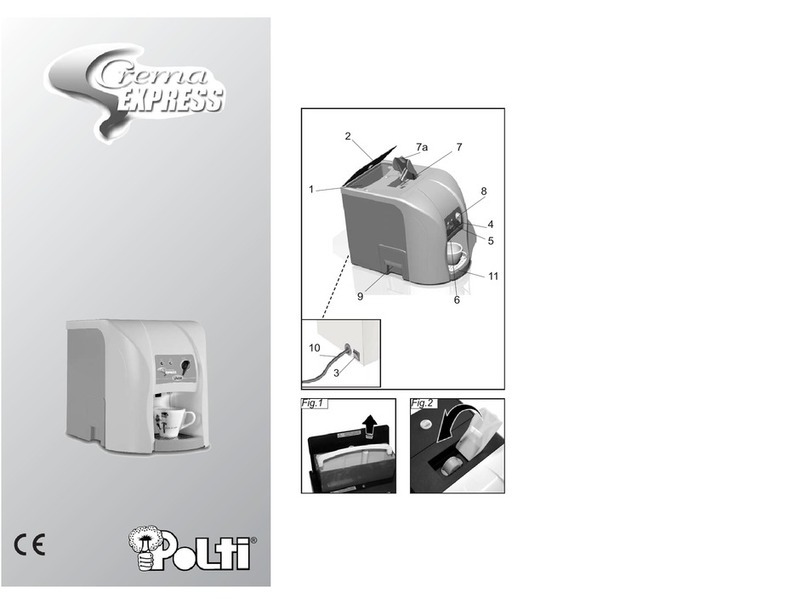
POLTI
POLTI CREMA EXPRESS Usage instructions
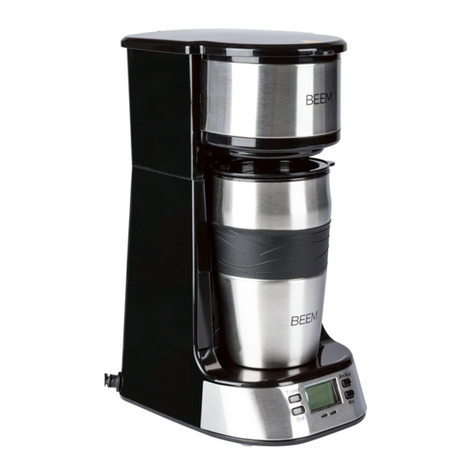
Beem
Beem Single-Kaffeemaschine Thermo2Go CM-119A instruction manual
